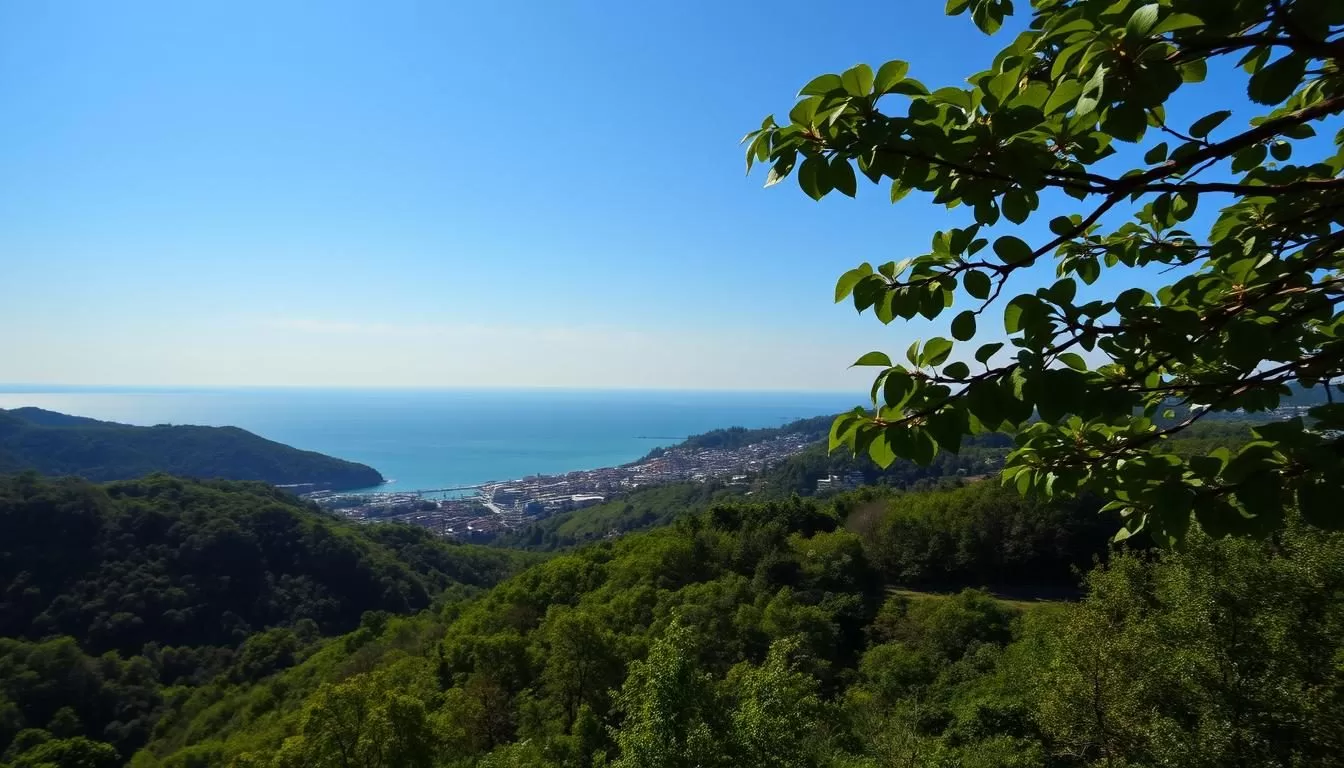✓ Accommodations✓ Flights✓ Rental Cars
Planning a trip to Ōita Prefecture can be a delightful experience, especially when you’re aware of the ideal time to visit. Located on the east coast of Kyushu, Ōita is famous for its hot spring towns, historical sites, and breathtaking natural beauty.
As you prepare for your journey, understanding the seasonal weather patterns in Ōita is crucial. The region’s climate varies across its northern, central, western, and southern areas, making some times of the year more suitable for your activities than others.
Whether you’re drawn to the cherry blossoms of spring, the colorful autumns, or the onsen-perfect winters, this guide will help you navigate the best time to visit Japan and make the most of your trip.
Understanding Ōita Prefecture’s Climate
Ōita Prefecture’s diverse geography significantly influences its climate, making it essential to understand the various weather patterns across the region. This understanding will help you plan your trip more effectively, ensuring that you make the most of your visit.
Geographic Location and Weather Patterns
Ōita Prefecture is located on the island of Kyushu, Japan, and its geography plays a crucial role in shaping its climate. The prefecture’s terrain varies from coastal areas to mountains, leading to diverse weather patterns. The temperature and weather conditions vary significantly across different areas, with some regions experiencing extreme heat during the summer, while others remain relatively mild.
Regional Climate Variations Within Ōita
The climate in Ōita varies significantly across its regions. In the northern parts, such as Usa and Kunisaki, thunderstorms are frequent during the summer, and the weather tends to be poor and cloudy in winter. Central Ōita, including Beppu, Yufuin, and Ōita City, experiences extreme summer heat with temperatures often exceeding 35°C, but enjoys relatively pleasant winters. Western Ōita has numerous thunderstorms in summer and rainy days in winter, with occasional snowfall. Southern Ōita records the highest temperatures and heavy rainfall in summer, with pleasant and dry winters. As you travel through these areas, you’ll notice significant climate differences, affecting the best time to visit each region.
Ōita Prefecture, Japan: Best Months for a Weather-Savvy Trip
For a weather-savvy trip to Ōita, understanding the seasonal climate is key to a successful journey. Ōita Prefecture’s climate varies significantly across seasons, making some periods more ideal for visitation than others.
Spring and Autumn: The Ideal Seasons
Spring and autumn are considered the best seasons to visit Ōita due to their mild and pleasant weather. During these seasons, the temperatures are comfortable, making it ideal for outdoor activities and sightseeing. You can enjoy the cherry blossoms in the spring and the vibrant autumn foliage without the harsh weather conditions of summer or winter.
Shoulder Seasons for Budget Travelers
For travelers on a budget, considering the shoulder seasons can be beneficial. Visiting Ōita during late May to early June or late November to early December can offer significant savings on accommodations and flights. These periods provide pleasant weather with fewer tourists, making it an ideal time for those looking to avoid crowds.
| Season | Weather Conditions | Tourist Crowds | Budget Friendliness |
|---|---|---|---|
| Spring (March to May) | Mild, pleasant | High | No |
| Autumn (September to November) | Comfortable temperatures | High | No |
| Shoulder Season (Late May to early June, Late November) | Pleasant | Moderate | Yes |
| Peak Summer and Winter | Extreme weather | Varies | No |
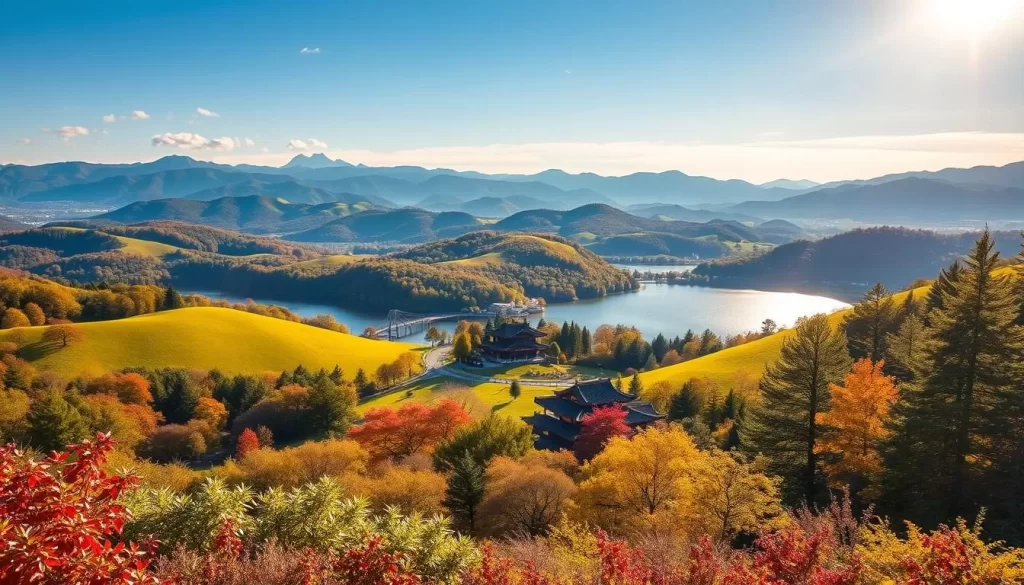
By planning your trip during the shoulder seasons and avoiding peak tourist periods, you can have a more budget-friendly and less crowded experience in Ōita Prefecture.
Spring in Ōita: Cherry Blossoms and Mild Weather
As winter fades, Ōita Prefecture awakens to the beauty of spring. This season brings mild weather, making it an ideal time to explore the region’s natural beauty and cultural attractions.
March: Early Spring Awakening
In March, Ōita starts to experience the early signs of spring. The weather begins to warm up, and you can enjoy the initial blooms of the season. It’s a great time to visit before the peak tourist season.
April: Peak Cherry Blossom Season
April is the peak month for cherry blossom viewing in Ōita. The prefecture is renowned for its beautiful sakura trees, and this is the best time to witness them in full bloom. You should be prepared for larger crowds during this period.
May: Pleasant Temperatures and Golden Week
May continues the pleasant weather trend, with temperatures rising to highs of around 24-25°C (75-77°F) and comfortable evenings around 15°C (59°F). Early May coincides with Golden Week, a peak holiday period in Japan, making it a busy time for domestic tourism. However, late May offers a more relaxed atmosphere with fewer crowds, making it an excellent time for budget-conscious travelers.
| Month | High Temperature (°C) | Low Temperature (°C) | Notable Events |
|---|---|---|---|
| March | 18.0 | 8.0 | Early spring awakening |
| April | 22.0 | 12.0 | Peak cherry blossom season |
| May | 24.1 | 15.0 | Golden Week, cultural festivals |
During spring, Ōita’s landscapes become increasingly picturesque with blooming flowers and lush greenery. You can enjoy various cultural festivals and events, making it a vibrant time to visit.
Summer in Ōita: Heat, Humidity, and Festivals
Summer in Ōita is a season of vibrant festivals and challenging weather conditions. As you plan your trip, it’s essential to understand the weather patterns and how they might impact your travel experience.
June: Rainy Season Considerations
June marks the beginning of the rainy season in Ōita, with increased precipitation and humidity. Visitors should be prepared for wet weather and potential disruptions to outdoor activities. Despite the rain, the lush green landscapes and fewer tourists can make for a serene experience.
July: Peak Heat and Summer Festivals
July brings peak heat to Ōita, with temperatures often reaching their highest levels. However, this month also hosts numerous summer festivals, showcasing local culture and traditions. Visitors can enjoy the vibrant atmosphere while taking necessary precautions against the heat.
August: Typhoon Season and Fireworks
August is characterized by high temperatures and humidity, as well as the risk of typhoons. On the other hand, it’s a great time to enjoy fireworks festivals and other summer events. With average highs around 32°C (90°F), it’s one of the hottest months, making it crucial to stay hydrated and plan activities accordingly.
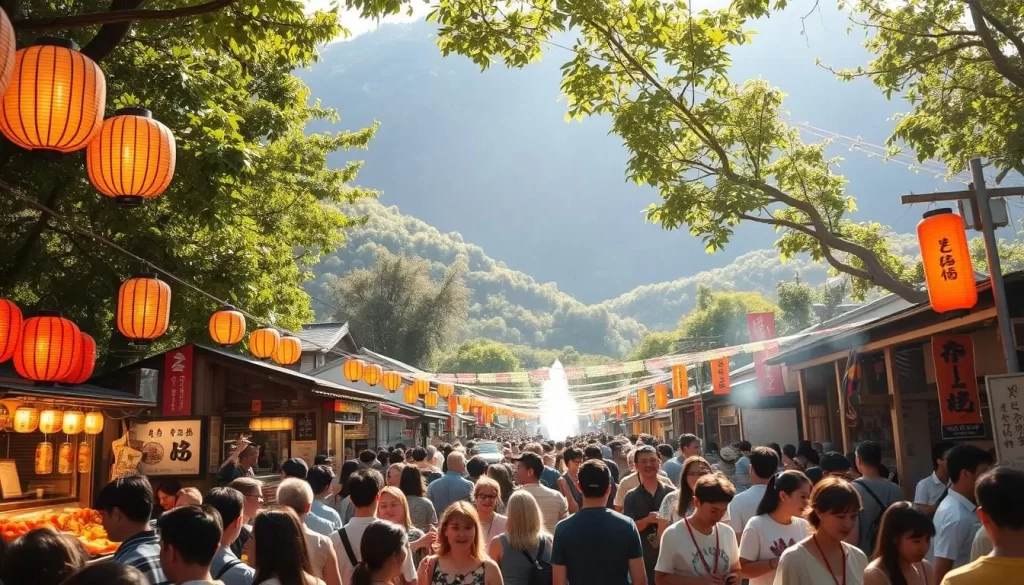
To make the most of your visit, consider exploring Ōita’s mountain destinations, such as Kuju and Kokonoe, which offer cooler climates. Planning your activities for early morning or later in the evening can also help you avoid the peak heat.
Autumn in Ōita: Colorful Foliage and Comfortable Temperatures
As summer fades, Ōita Prefecture transforms into a vibrant autumn landscape, offering comfortable temperatures and breathtaking foliage. This season is ideal for travelers seeking to enjoy the natural beauty and cultural attractions without the peak summer heat.
The autumn season brings a unique charm to Ōita, with the changing leaves creating a picturesque landscape. You can enjoy the mild weather and the vibrant colors of the trees, making it a perfect time for outdoor activities and sightseeing.
September: Transitional Weather Patterns
In September, Ōita experiences transitional weather, gradually cooling down from the summer highs. Daytime temperatures remain warm, while evenings start to become cooler, signaling the onset of autumn.
October: Peak Autumn Foliage
October is a prime month for viewing autumn foliage in Ōita, with the trees displaying a kaleidoscope of colors. The comfortable temperatures make it an excellent time for hiking and exploring the region’s natural beauty.
November: Cooler Temperatures and Fewer Crowds
By November, the autumn foliage is still present, especially in lower elevations and central areas. You can enjoy:
- Cooler temperatures, with daytime highs around 18°C (64°F) and chilly evenings.
- Fewer crowds, making it easier to visit popular attractions.
- The Oita Hikari no Fantasy illumination event, which begins in November.
- Clear, crisp air ideal for mountain views and stargazing.
Winter in Ōita: Hot Springs and Snow Activities
Winter in Ōita is a season of contrasts, where you can experience the tranquility of snow-covered landscapes and the warmth of natural hot springs. This unique blend makes Ōita an attractive destination during the colder months.
December: Early Winter and Festive Atmosphere
December marks the beginning of winter in Ōita, with a festive atmosphere prevailing throughout the prefecture. The temperature starts to drop, but it’s still relatively mild compared to peak winter months, making it a great time to enjoy outdoor activities and local festivities.
January: Peak Winter and Onsen Experience
January is the coldest month in Ōita, offering a peak winter experience. It’s an ideal time to indulge in the prefecture’s famous onsen (hot springs), particularly in places like Beppu and Yufuin, where the contrast between the cold air and warm waters is most enjoyable.
February: Winter Festivals and Snow Activities
February continues the winter season, with many regions still experiencing snow. You can enjoy winter activities, visit onsen, and participate in local festivals. Western Ōita areas like Kokonoe may still have snow, offering winter scenery without needing to travel far. The month also sees the celebration of Setsubun, with special events at temples and shrines throughout Ōita.
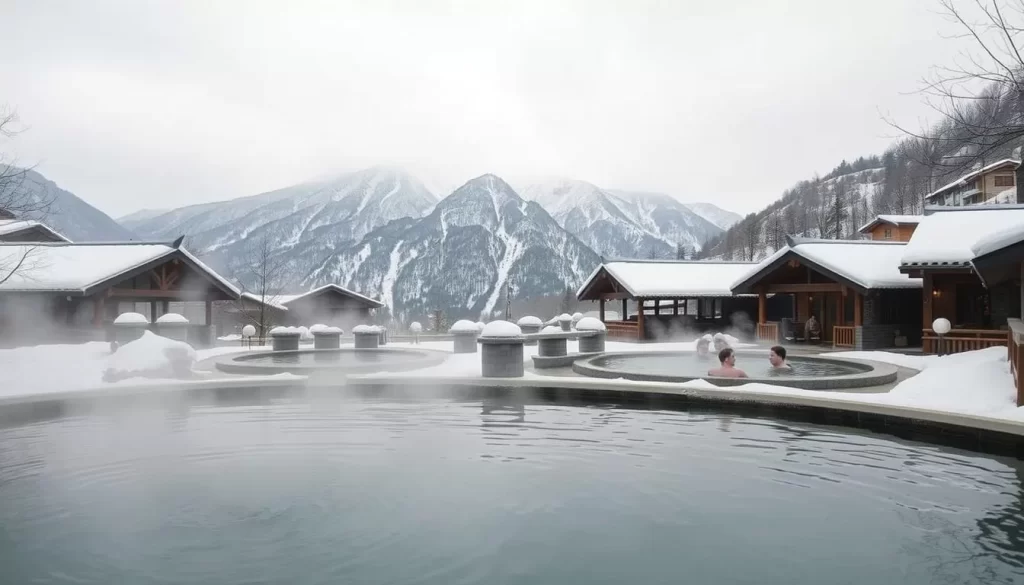
Regional Weather Variations in Ōita Prefecture
As you travel through Ōita Prefecture, you’ll notice distinct regional weather patterns. The diverse geography, from coastal areas to mountains, contributes to these variations.
Northern Ōita: Usa and Kunisaki
Northern Ōita, including areas like Usa and Kunisaki, experiences a unique blend of weather. The region’s climate is influenced by its proximity to the coast and the mountains. You can expect a mix of mild temperatures and seasonal changes.
Central Ōita: Beppu, Yufuin, and Ōita City
Central Ōita, encompassing Beppu, Yufuin, and Ōita City, has its own weather characteristics. Beppu is known for its hot springs and relatively mild climate, while Yufuin offers a more mountainous weather experience. Summer can be hot and humid, while winters are generally mild.
Western Ōita: Hita and Kokonoe
Western Ōita, including Hita and Kokonoe, has a distinct climate influenced by its inland location. The region experiences a more continental climate with colder winters and warmer summers. This area is known for its natural beauty during the autumn season.
Southern Ōita: Usuki, Saiki, and Bungo-Ono
Southern Ōita, covering Usuki, Saiki, and Bungo-Ono, is characterized by extreme summer heat and heavy rainfall. In contrast, winters are pleasant with dry air, making it an ideal time to visit historic sites like Usuki’s stone Buddha carvings. Coastal areas like Saiki offer relief from the summer heat with their sea breezes.
Rainfall and Humidity: What to Expect
To make the most of your trip to Ōita, it’s vital to be aware of the rainfall and humidity patterns. Understanding these weather conditions will help you plan your activities and pack accordingly, ensuring a more enjoyable experience.
Rainy Season (June-July)
The rainy season in Ōita typically occurs from June to July. During this period, you can expect significant rainfall, which may impact your outdoor plans. The rain can be heavy at times, but it’s also a good time to see the lush greenery and enjoy the cooler temperatures. Be prepared for wet weather by bringing appropriate gear, such as umbrellas and raincoats.
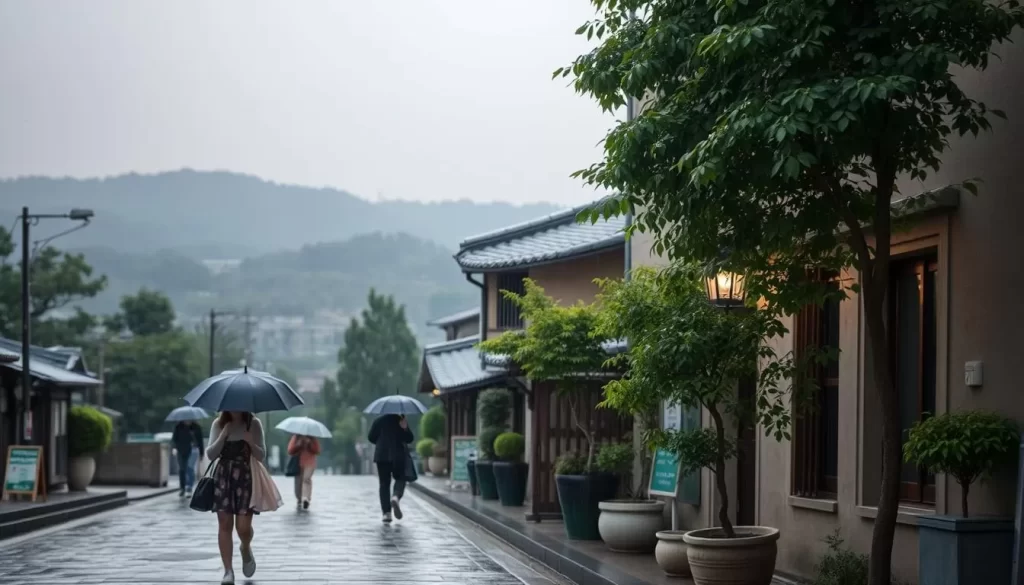
Managing Humidity in Summer Months
Ōita’s summer months are characterized by high humidity, particularly from June to September, with August being the most oppressive. The combination of high temperatures often exceeding 30°C (86°F) and humidity above 80% creates a heat index that can feel several degrees warmer than the actual temperature. To manage the humidity, plan your outdoor activities for early morning or evening and seek air-conditioned spaces during the hottest part of the day. Wearing lightweight, quick-drying clothing made from natural fibers like cotton or linen can also help you stay more comfortable. Additionally, staying properly hydrated is essential to avoid dehydration.
Planning Around Crowds and Tourist Seasons
When planning your trip to Ōita Prefecture, it’s essential to consider the crowds and tourist seasons to make the most of your travel experience. Understanding when the peak tourist periods are can help you avoid the crowds and make informed decisions about your travel plans.
Peak Tourist Periods to Avoid
Ōita Prefecture experiences a surge in tourism during certain periods, which can impact your travel experience. The peak tourist seasons include cherry blossom season, Obon festival, Golden Week, and New Year’s holidays. During these times, popular destinations are crowded, and prices for flights and accommodations tend to be higher. If you’re looking for a more relaxed experience, it’s best to avoid these periods.
Best Times for Budget-Friendly Travel
If you’re on a budget, consider visiting Ōita Prefecture during the shoulder seasons. The periods between peak and off-peak times offer the best value for money. You can find pleasant weather and lower accommodation rates during late May to early June and late November to mid-December. Additionally, January and February, excluding the New Year period, offer the lowest accommodation prices, especially in hot spring resorts like Beppu and Yufuin.
To make the most of your budget-friendly travel, consider visiting during weekdays instead of weekends. Sunday through Thursday nights tend to be less expensive than Friday and Saturday nights. Here’s a summary of the best times to visit Ōita Prefecture:
| Period | Characteristics | Best For |
|---|---|---|
| Late May to early June | Pleasant weather, lower accommodation rates | Budget-friendly travel |
| Late November to mid-December | Autumn beauty, reduced rates | Budget-friendly travel, autumn foliage |
| January and February (excluding New Year) | Lowest accommodation prices | Budget-friendly travel, hot spring resorts |
| Weekdays (Sunday-Thursday) | Less expensive accommodation rates | Budget-friendly travel |
What to Pack for Each Season in Ōita
Understanding what to pack for each season in Ōita will help you navigate the prefecture’s unique climate with ease. As you prepare for your trip, consider the distinct characteristics of each season to ensure you’re well-equipped for your weather-savvy adventure.
Spring and Autumn Essentials
During spring and autumn, Ōita’s mild temperatures make it an ideal time to visit. For these seasons, pack layers, including lightweight jackets and comfortable clothing for outdoor activities. You can expect pleasant weather with mild temperatures, making it perfect for exploring the prefecture.
Summer Heat Survival Kit
In the summer, Ōita can be hot and humid. To survive the heat, pack lightweight, breathable clothing, sunscreen, and a hat to protect yourself from the sun. Don’t forget to stay hydrated by bringing a refillable water bottle.
Winter Layering Strategy
winter, be prepared for cold temperatures, especially at night. A layering strategy works best, starting with thermal base layers, adding sweaters or fleece mid-layers, and topping with a waterproof outer layer. You’ll need a good quality down jacket or warm coat, particularly if you’ll be visiting western Ōita where it’s colder. Don’t forget accessories like gloves, a scarf, and a warm hat. The dry weather can affect your skin, so pack moisturizer, lip balm, and hand cream to combat dryness.
Must-Visit Seasonal Attractions in Ōita
As you explore Ōita throughout the year, you’ll discover a range of must-visit attractions that showcase its unique charm. The prefecture offers diverse experiences across different seasons, making it a fascinating destination for tourists.
Spring: Cherry Blossom Viewing Spots
Spring in Ōita is highlighted by its beautiful cherry blossoms. Popular spots for cherry blossom viewing include various parks and gardens throughout the prefecture. The mild weather makes it an ideal time to enjoy outdoor activities.
Summer: Festivals and Outdoor Activities
Summer in Ōita is characterized by vibrant festivals and a range of outdoor activities. Visitors can enjoy summer festivals, swimming, and other outdoor pursuits during this time. The warm weather is perfect for exploring the prefecture’s natural beauty.
Autumn: Foliage Viewing Locations
Autumn brings stunning foliage to Ōita, with numerous locations offering breathtaking views. Popular spots include mountains and gardens, where visitors can enjoy the colorful foliage.
Winter: Hot Springs and Snow Experiences
Winter transforms Ōita into a serene landscape, ideal for visiting hot springs (onsen) and enjoying snow-related activities. Beppu’s “Hells” take on a mystical quality, and Kokonoe offers unique snow-covered experiences.
| Season | Attractions | Activities |
|---|---|---|
| Spring | Cherry Blossoms | Hanami (Blossom Viewing) |
| Summer | Festivals | Swimming, Outdoor Activities |
| Autumn | Foliage | Hiking, Sightseeing |
| Winter | Hot Springs, Snow | Onsen, Snow Activities |
Conclusion: Making the Most of Your Weather-Savvy Trip to Ōita
Whether you’re drawn to cherry blossoms or hot springs, Ōita Prefecture has something to offer every season. With a comprehensive understanding of Ōita’s weather patterns throughout the year, you can now plan the perfect trip.
Spring (March-May) and autumn (September-November) are the best times to visit, offering pleasant temperatures and natural beauty. If you’re seeking a quintessential hot spring experience, winter (December-February) is ideal, despite the cooler temperatures.
For budget-conscious travelers, the shoulder seasons of late May to early June and late November to mid-December offer good weather with lower prices and fewer crowds. Understanding regional variations within Ōita will help you adapt your itinerary to make the most of your trip.
Remember to check specific event dates like Golden Week and New Year holidays when planning your trip, as these can significantly impact crowds and prices. With this guide, you’re now equipped to experience the best of Ōita Prefecture, whether you’re seeking cherry blossoms, autumn foliage, summer festivals, or winter hot spring experiences, making your visit Japan truly unforgettable.
The above is subject to change.
Check back often to TRAVEL.COM for the latest travel tips and deals.
